Today, President Obama is hosting the fourth-ever White House Science Fair, which will feature extraordinary science projects and experiments from some of America’s most innovative students.
Find out more below about the students participating in this year’s Science Fair:
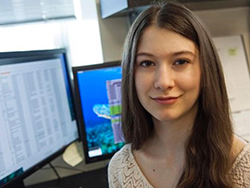 Elana Simon, 18 (New York, New York)
Elana Simon, 18 (New York, New York)
After surviving a bout with a rare liver cancer at age 12, Elana Simon, now 18, teamed up with one of the surgeons who treated her, set up shop in a medical lab, and began to collect much-needed data about the rare illness she'd endured. She gathered tissue samples from patients coping with the same cancer, fibrolamellar, performed genomic sequencing tests, and found a common genetic mutation across all of the samples she collected. Elana's results were published in the top journal Science, and formed a basis for a new website, the Fibrolamellar Registry, which she built to help empower fibrolamellar patients to share their own medical data for use by researchers working to find a cure. Elana is a recent winner of the American Association for Cancer Research's Junior Champion in Cancer Research Award. She has presented her work before an audience of 16,000 cancer researchers and is headed to Harvard to study computer science in the fall.
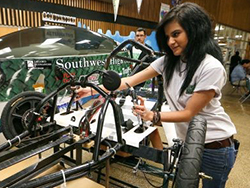 Deidre Carrillo, 18 (San Antonio, TX)
Deidre Carrillo, 18 (San Antonio, TX)
Deidre Carrillo, 18, knows what it's like to sit behind the wheel of an innovative electric vehicle she helped design and build, and to feel the adrenaline rush of racing it over a finish line. Deidre leads and helped found her high school's Southwest Engineering Team, which competes annually in Florida's Emerald Coast Electrathon-a national competition for student-built electric cars. For the first six months of the team's existence, Deidre was the only female member. As driver of the team's Dragon 1 vehicle, she helped lead her team to second place finishes in the Electrathon for two years in a row, before grabbing a first place finish in the 2014 competition this year. After graduation, Deidre plans to study public relations at Texas A&M University.
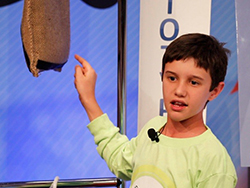 Peyton Robertson, 12 (Fort Lauderdale, Florida)
Peyton Robertson, 12 (Fort Lauderdale, Florida)
Peyton Robertson has seen firsthand the damages wrought by salt-water flooding in his own South Florida community -- a problem that costs the region millions of dollars each year. Peyton built an innovative prototype "sandless" sandbag that can better protect flood zones, like his own community, against salt-water damage. His design is also lightweight, easy to store, and more effective at keeping water out than existing designs. Peyton was named America's Top Young Scientist at the 2013 Discovery Education 3M Young Scientist Challenge and received $25,000 for his innovative design.
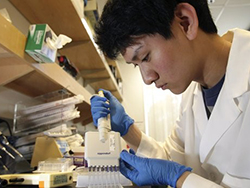 Eric Chen, 18 (San Diego, CA)
Eric Chen, 18 (San Diego, CA)
After following news of the 2009 swine flu outbreaks, Eric Chen, 17, decided there was something he could do to help. Eric took on a research project aimed at finding ways to protect people from dangerous influenza viruses such as H5N1 and H7N9, which pose a threats to populations around the world. As part of a microbiology project, Eric identified new drug candidates for the treatment of influenza -- research that may lead to a new class of anti-flu medicines that could protect against a flu pandemic while new vaccines are being developed. Eric's potentially game-changing work earned him the grand prizes at the 2013 Google Science Fair and Siemens Competition in Math, Science, and Technology, as well as places in the 2014 Intel Science Talent Search and 2013 Intel International Science and Engineering Fair.
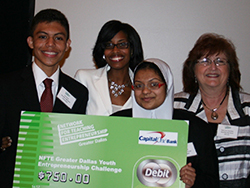 Amena Jamali, 16; Juan Ramos, 17 (Dallas, TX)
Amena Jamali, 16; Juan Ramos, 17 (Dallas, TX)
Juan Ramos moved to the United States from El Salvador two years ago, barely speaking a word of English. He quickly caught up and, with classmate Amena Jamali, launched JJ New World, a company that creates software programs specializing in online games. The students' premier game, "Better than History," helps players think critically and view the world through a more informed lens as they navigate alternative endings to true historical events. Amena and Juan plan to use the income raised from their business to fund scholarships and poverty reduction programs in India and El Salvador, their families' countries of origin. Juan and Amena won 1st place at the Network for Teaching Entrepreneurship (NFTE) North Texas Regional Business Plan Challenge, and were quarter-finalists in NFTE's National Youth Entrepreneurship Challenge.
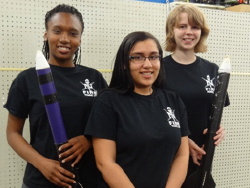 Rebecca Chapin-Ridgely, 17; Jasmyn Logan, 15; and Nia'mani Robinson, 15 (Prince George's and Anne Arundel Counties, Maryland)
Rebecca Chapin-Ridgely, 17; Jasmyn Logan, 15; and Nia'mani Robinson, 15 (Prince George's and Anne Arundel Counties, Maryland)
"Team Rocket Power" was one of 100 teams that qualified for last year's Team America Rocketry Challenge (TARC). It was also one of just nine all-girl teams that qualified for the student rocketry competition and the only African American all-girl team. As proud members of Team Rocket Power, Rebecca Chapin-Ridgely, 17, Jasmyn Logan, 15, and Nia'mani Robinson, 15, gave up their weekends and free time after school to build and test their bright purple rocket -- which is designed to launch to an altitude of about 750 ft, and then return a "payload" (an egg) to the ground safely. The girls are looking forward to applying their rocketry expertise in diverse fields when they get to college -- including medicine, journalism, and architecture.
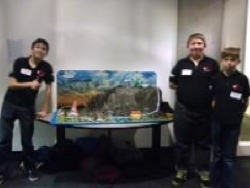 Joshua Troutman, 13; Tanner Schantz, 13 (Bismarck, ND)
Joshua Troutman, 13; Tanner Schantz, 13 (Bismarck, ND)
Carrie's Kids Inc., an all-volunteer ministry, helped Joshua Troutman, 13, and Tanner Schantz, 13, harness their talents and skills to compete in the Future City Competition-which challenges students to imagine, design, and build sustainable cities of the future. Joshua, Isaac, and Tanner are at-risk for or experiencing homelessness, battling social disorders, or coping with difficult family situations. Their teacher, Carrie Grosz, says these "extremely crafty and creative kids" overcame real anxieties and challenges by working together for countless hours after school and on weekends to engineer a hypothetical city with a sustainable transit system. The boys' city, called "Whitewater Crossing," employs an innovative, cost-efficient, climate-controlled, elevated monorail system. The design earned the team the Future City Students' Choice Award at the 2013-2014 Minnesota Regional Competition.
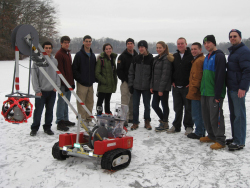 Olivia Van Amsterdam, 16; Katelyn Sweeney, 17 (Natick, MA)
Olivia Van Amsterdam, 16; Katelyn Sweeney, 17 (Natick, MA)
Olivia Van Amsterdam, 16, Katelyn Sweeney, 17, and their team of student engineers invented a 120-lb. remotely operated vehicle (ROV) that can help ice search and rescue dive teams search for bodies in dangerous waters. Their submersible device works in waters up to 40 feet deep with temperatures of 33-45°F. Working with their teacher and pro bono lawyers, the girls are currently working to file a U.S. patent application and hope to one day license their ROV technology. Their "InvenTeam" team presented its work at the 2013 Lemelson-MIT Program's Eureka Fest celebration at the Massachusetts Institute of Technology (MIT). When not building bots that can save lives, Olivia and Katelyn aim to be role models for other aspiring girl engineers -- both volunteering as tutors and mentors. Katelyn will start as a freshman at MIT this fall. Olivia is excited to begin her college search.
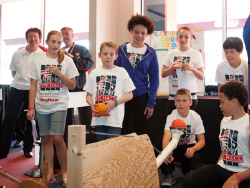 Brook Bohn, 14; Daisjaughn Bass, 13; Gerry McManus, 13 (Hudson, MA)
Brook Bohn, 14; Daisjaughn Bass, 13; Gerry McManus, 13 (Hudson, MA)
Raytheon and the New England Patriots have partnered to create a science fair that encourages Boys and Girls Club members from across New England to explore the math and science behind the sports they love. For the Fair, the Massachussetts-based "Catapult Court CEOs" -- a team of 11- to 14-year-old students -- engineered and built a custom-made catapult to determine whether they could improve basketball-shot performance. By shooting over and again from an individual's optimal distance and angle from the hoop, the CEOs set out to prove that maximizing accuracy and precision when shooting baskets provides the highest level of performance on the basketball court. Their invention earned the team second prize at Raytheon's and the Patriots' 2013 Science of Sports Science Fair.
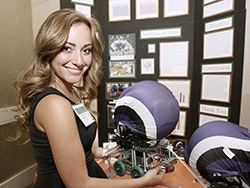 Maria Hanes, 19 (Santa Cruz, CA)
Maria Hanes, 19 (Santa Cruz, CA)
Maria Hanes, 19, dreams of becoming the first female collegiate football coach-and she's already built up some impressive credentials. Maria served as manager and film technician for the Desert Scorpions football team during her first three years of high school at Edwards Air Force Base, aiming to learn as much as possible about the game she loves. One afternoon, she dropped her cell phone, covered with a new rubber case, and noticed that the phone didn't break. She set out to test whether soft, impact-absorbing materials like the rubber case could be added to helmets to reduce concussion risk. Maria developed her "Concussion Cushion" science project, testing out several inner and outer cushioning materials for her players' helmets -- including gel and memory foam inserts and impact -- absorbing outer coverings. Maria's project earned her the Naval Science Award and place at the 2013 California State Science Fair.
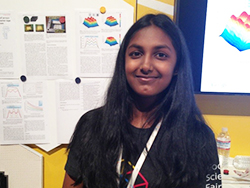 Kavita Selva, 14 (Houston, TX)
Kavita Selva, 14 (Houston, TX)
After reading a story in National Geographic about the global shortage of metals and elements used in magnets -- called "rare earths" -- and how important magnets are to objects like motors and wind turbines, Kavita Selva, 14, set out to design a strong magnet that contains little or no rare materials. She used superconductor tape, a strip of metal tape coated with superconductor material to develop a strong magnet containing just a small amount of rare-earths. Kavita has already published some of her results with a professor at the University of Houston and earned a place as finalist in the 2013 Google Science Fair.
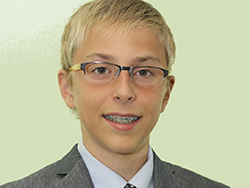 Alex Spiride, 14 (Plano, TX)
Alex Spiride, 14 (Plano, TX)
Competitive swimmer Alex Spiride, 14, loves water and loves science. Inspired by the quiet, powerful locomotion of squids and jellyfish, and after reading articles about cutting-edge research on soft, flexible robots, Alex design Squid Jet -- a fast, efficient, and noise-limited underwater vehicle. Squid-Jet is a bio-inspired robot that uses the same kind of jet propulsion employed by sea creatures to get around. The device contains an inner bladder that squeezes and pushes out water to propel itself forward, outperforming current manmade propulsion systems and reaching speeds in excess of 30 cm/second. Alex hopes his invention can be used by marine biologists to study underwater ecosystems efficiently, with disturbing creatures with the noise of a propeller. Alex is a finalist in the 2013 Google Science Fair.
 Nicolas Badila, 15 (Jonesboro, GA)
Nicolas Badila, 15 (Jonesboro, GA)
Nicolas Badila, 15, a home-schooled student from Georgia, created his own STEM-themed virtual world, STEMville, where students can pick a character, play challenging games, and improve their STEM skills. Nicolas spends much of his free time captaining a Robotics team -- the "Steampunk Afros" -- with the Hundred Black Men of Atlanta initiative -- an organization focused on community empowerment and supporting Atlanta's underprivileged youth. He also leads a computer science and robotics program within his homeschooling group. In the future, Nicolas hopes to work in robotics and open a center to teach kids computer languages, game development, and robotics. STEMville earned Nicolas the title of Middle School Open Platform Winner at the National STEM Video Game Challenge.
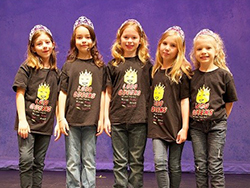 Avery Dodson, 8; Natalie Hurley, 8; Miriam Schaffer, 8; Claire Winton, 8; Lucy Claire Sharp, 8 (Tulsa, OK)
Avery Dodson, 8; Natalie Hurley, 8; Miriam Schaffer, 8; Claire Winton, 8; Lucy Claire Sharp, 8 (Tulsa, OK)
Girl Scout Troop 2612 put their preparedness skills into action as part of the Junior FIRST Lego League's Disaster Blaster Challenge-which invites thousands of elementary-school-aged students from across the country to explore how simple machines, motorized parts, engineering, and math can help solve problems posed by natural disasters like floods or earthquakes. Recalling the recent, damaging summer floods in Estes Park, Colorado, the Troop noticed that first responders weren't able to easily reach certain communities because bridges had been washed out -- and set out to design a solution. The girls invented the "Flood Proof Bridge," and built a model of their idea-not only mechanizing the bridge using motors and the correct gear ratios, but also developing, from scratch, a simple computer program to automatically retract the bridge when flood conditions are detected by a motion sensor embedded in the river bed. The girls are excited to keep brainstorming about new designs to help solve big challenges.
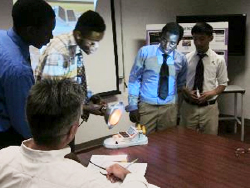 Ekeagwu Onyekachi, 20; Jevaughn Taylor, 19; Iragena Serge Bangamwabo, 20; Abhishek Yonghang-Subba, 18; and De'onte Green, 19 (Baltimore, MD)
Ekeagwu Onyekachi, 20; Jevaughn Taylor, 19; Iragena Serge Bangamwabo, 20; Abhishek Yonghang-Subba, 18; and De'onte Green, 19 (Baltimore, MD)
A team of five Maryland teens harnessed the power of the sun to create a working mini "hovercraft" toy. The team's design-which includes three 6V motors, a 180-degree servo motor, and two 5v solar panels-started by developing a 3-D model, and built the physical prototype from recyclable, environmental friendly material. The resulting device, the Green Tech Solar Hovercraft, helped the team win first place at the Network for Teaching Entrepreneurship (NFTE) Baltimore STEM business Plan Competition. The students are studying a range of engineering- and computer science-related subjects in high school and college, and one team member, Denote Green, 19, will be entering the U.S. National Guard in June, after his high school graduation.
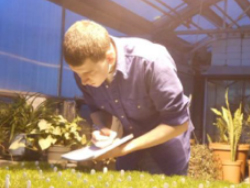 Connor Klemenhagen, 18 (Champlin, MN)
Connor Klemenhagen, 18 (Champlin, MN)
Connor Klemenhagen, 18, was inspired to explore the science of turfgrass after a seventh-grade field trip to the Cedar Creek Ecosystem Science Reserve. He then learned that turfgrass is the largest irrigated crop in the United States — occupying more land area that corn, wheat, and soybeans combined. Connor’s ongoing research aims to find ways to reduce the amount water needed to maintain healthy lawns, making more water available for drinking and agricultural demands. His research won him the 2013 National Junior Science and Humanities Symposium, a competition sponsored by the Army, Navy, and Air Force. Connor is a freshman at the University of Minnesota and a cadet in the Army ROTC program.
 Cassandra Baquero, 13; Caitlin Gonzolez , 12; Janessa Leija, 11 (Los Fresnos, Texas
Cassandra Baquero, 13; Caitlin Gonzolez , 12; Janessa Leija, 11 (Los Fresnos, Texas)
Together, Cassandra Baquero, 13, Caitlyn Gonzolez, 12, and Janessa Leija, 11 -- part of an all-girl team of app-builders from Resaca Middle School in Texas -- designed an innovative solution to help one of their visually impaired classmates. The students built "Hello Navi" -- an app that gives give verbal directions to help users navigate unfamiliar spaces based on measurements of a user's stride and digital building-blueprints. The service makes use of common digital tools such as a compass and optical Braille readers and can be tailored for use in any building. The girls' invention made them one of eight teams to win the recent Verizon Innovative App Challenge, and also earned their school a $20,000 grant from the Verizon Foundation.
 Felege Gebru, 18; Karen Fan, 17 (Newton, MA)
Felege Gebru, 18; Karen Fan, 17 (Newton, MA)
Noting the sobering statistic that Ethiopia has the highest rate of pedestrian deaths by vehicle in the world, Felege Gebru, 18, and Karen Fan, 17, designed a pedestrian alert system for use in Addis Ababa, Ethiopia, that alerts drivers to crossing pedestrians and helps pedestrians safely cross congested roads. The invention, designed to be powered by solar energy, uses a dual-sensor method to calculate the arrival time of oncoming vehicles and indicate safer crossing times to pedestrians. Felege and Karen are leaders of the Newton North High School "InvenTeam" -- which works on prototype solutions to be showcased each June at the Lemelson-MIT Program's EurekaFest event. Both team members are naturalized U.S. citizens. Felege is a freshman studying Computer Science and Visual Arts at Brown University. Karen is a high-school senior and captain of her school's badminton team.
 Katia Castañeda, 19 (Oakland, CA)
Katia Castañeda, 19 (Oakland, CA)
After happening upon a visually impaired neighbor of hers walking in the street, Katia Castañeda, 19, decided to harness her tech skills to help people like her neighbor stay safe. She developed an electronic cane that senses what is ahead of it using two sonar sensors and then warns its user about any potential obstacles. Katia is a student at the Lighthouse Community Charter School -- an Oakland, California, public school serving low-income youth, which focuses on empowering students to design and "make." After displaying her prototype at a Maker Faire, Katia received several offers to help her develop and manufacture the product.
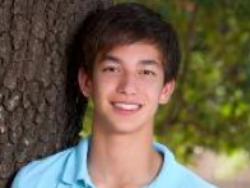 Frederick Lang, 18 (Houston, TX)
Frederick Lang, 18 (Houston, TX)
Frederick Lang, 18, has two parents who are physicians in a cancer center. Hearing stories of the difficulties their patients face drove him to pursue research that might help improve outcomes for cancer patients. Through his research, Frederick identified a potential new treatment for glioblastoma multiforme, the most malignant type of adult brain cancer, using human mesenchymal stem cells to secrete exosomes that contain anticancer microRNA -- a project that earned him a $10,000 scholarship from the Siemens Foundation. Frederick's favorite subject is organic chemistry. He is a National Merit Scholar Semifinalist, captain of his school's varsity soccer team, and is currently considering a profession biomedical research or engineering.
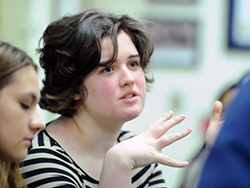 Anne Merrill, 17 (Old Greenwich, CT)
Anne Merrill, 17 (Old Greenwich, CT)
Anne Merrill, 17, is inspired by nature -- both scientifically and artistically. As a finalist in the Intel Science Talent Search 2014, Anne studied natural, non-chemical methods for suppressing soil-borne diseases. She looked at how "biochars," a charcoal-like material created by burning organic waste to sequester carbon, can be integrated into topsoil by earthworms as they burrow and digest soil. Her results suggest that combining the natural methods of earthworm bioturbation with biochars in soil may help reduce carbon emissions, prevent the spread of plant-borne E. coli, and increase agricultural yields. Anne is president of her high school's art club, has exhibited her nature-inspired art in several shows, and placed first in Princeton University's Playwriting Competition.
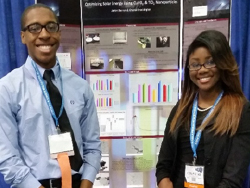 Crystal Brockington, 18; Aaron Barron, 18 (Conyers, GA)
Crystal Brockington, 18; Aaron Barron, 18 (Conyers, GA)
Noting that in the duration of just one hour, the Earth encounters more solar energy than the world population uses in a year, Crystal Brockington and Aaron Barron, both 18, set out to harness the power of the sun more efficiently than ever before. The pair -- self-dubbed as the "Nanocrystals'" -- conducted research to determine which alternative material could be used in quantum dots -- a key type of semi-conductor that makes solar cells work more efficiently -- to create a more efficient, cost-effective solar cell that works without cadmium, a material traditionally that is detrimental to the environment. Their research project was built around a comprehensive study plan and project design component, including a cost analysis of different types of solar cells. The team's work earned them the High School Grand Prize at the Seimens We Can Change the World Challenge.
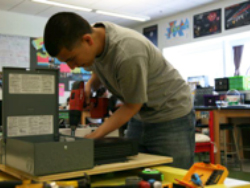 Kevin Barrios, 18; Saul Soto, 18 (Oakland, CA)
Kevin Barrios, 18; Saul Soto, 18 (Oakland, CA)
Kevin Barrios and Saul Soto, both 18, developed a portable solar charging system to charge an electric scooter. The system is designed to be able to provide power in remote locations and to be quick and easy to setup. Kevin and Saul's project was initially focused on creating an electric go-cart, but their plans got derailed when the prototype go-cart was stolen. These young men didn’t give up, using surplus and donated supplies from their community and shifting their focus to build and wire a scooter-charging station. Kevin and Saul completed their project as students at Lighthouse Community Charter School — an Oakland, California, public school serving low-income youth, which focuses on empowering students to design and “make.” Their innovative design was showcased at the Maker Faire.
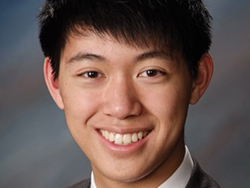 Henry Lin, 18 (Shreveport, LA)
Henry Lin, 18 (Shreveport, LA)
By simulating thousands of clusters of galaxies, Henry Lin, 18, has provided scientists with valuable new data, allowing them to better understand the mysteries of astrophysics: dark matter, dark energy and the balance of heating and cooling in the universe's most massive objects. For his innovative work on galaxy clusters, Henry received one of two Intel Foundation Young Scientist Awards of $50,000 at the Intel International Science and Engineering Fair in 2013. In 2012, Henry's project on cosmic accelerated expansion won him a trip to tour CERN, among other awards. In 2013, Henry delivered a TED Youth Talk, calling galaxy clusters, "beautiful objects" that are "mysterious," "surprising," and "useful -- as the universe's most massive laboratories."
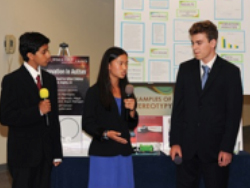 Jonathan Berman, 15; Maya Flannery, 15; Arjun Mahajian, 15 (Culver City, CA)
Jonathan Berman, 15; Maya Flannery, 15; Arjun Mahajian, 15 (Culver City, CA)
Three California 15-year-olds, Jonathan Berman, Maya Flannery, and Arjun Mahajian, teamed up to study stereotypy -- a behavioral issue involving repetitive or ritualistic movement that often manifests in children with autism. Recognizing that stereotypy can create social barriers and interfere with a student's ability to focus and learn, the students set out to design a motion-detecting bracelet that could signal to a child through vibration that they were stereotyping, allowing the child to address the behavior in real time. The project-called Innovation in Autism-earned the team a place as finalist in the Google Science Fair and 1st Place at eCybermission, a free, web-based science, math, and technology competition for middle-school students that is sponsored by the U.S. Army.
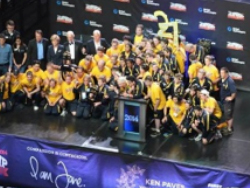 Courtney Hughes, 16; Matthew Pasco, 17 (Clarkston, MI)
Courtney Hughes, 16; Matthew Pasco, 17 (Clarkston, MI)
Courtney Hughes, 16, and Matthew Pasco, 17, represent a Michigan robotics team who competed fiercely on a national stage at this year's FIRST Robotics Competition -- which challenges teams of 25 students or more to build and program robots that perform prescribed tasks. The Michigan team was recognized not just for its robot-building prowess, but also serving as a model for other teams to emulate and best embodying the spirit of the FIRST competition. The team's motto is to develop engaged leaders who inspire innovation and advocate for all young minds to be inspired in STEM. In addition to designing competitive robots, they lead outreach in their communities old to share their love of science, technology, and innovation with the young and old -- including through summer engineering camps, organizing and executing a boat design competition and regatta, and bringing STEM to town parades.
 Parker Owen, 20 (Mobile, AL)
Parker Owen, 20 (Mobile, AL)
20-year-old Parker Owen from Mobile, AL, designed a prosthetic leg made entirely of a single bicycle as a cost-effective solution to make prosthetics more accessible in developing countries. Paker was inspired after learning that a local mission trip to Honduras raises $10,000 in donations each year, but that is only enough to buy components for four prosthetic legs. Parker designed the "Cycle-Leg" as a solution to significantly improve the quality of life of people in the developing world and made the. The Cycle-Leg is made entirely from the parts of a recycled bicycle, with the addition of three bolts, three nuts, and a few zip-ties. The leg has adjustable muscle fibers and tendons which are made from the bicycle's tire tubes, providing the resistance and force needed during strenuous activities. The synthetic muscles adjust with simple air pressure. The Cycle-Leg is adjustable to fit any size person and is designed to incorporate growth as well as muscle gain and loss of the individual over the course of a lifetime. Parker's Cycle-leg won him the 2013 FIRST Future Innovators Award.
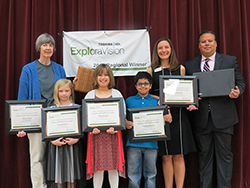 Ciara Newberry, 8; Elora Johnson, 8; Swapneel Mandal, 7 (Edmond, OK)
Ciara Newberry, 8; Elora Johnson, 8; Swapneel Mandal, 7 (Edmond, OK)
Three second-grade students from John Ross Elementary School in Edmond, Oklahoma, put their heads together to help solve a problem on the minds of many American parents: the threat of children overheating while sitting in too-hot cars. The students designed the "Hot Car Safety System," which sounds an alarm when a car becomes too hot for people or animals. Weight sensors placed under the seats of the car ensure that the system turns on to protect all occupants. As part of entering their design into the National Science Teachers Association ExploraVision competition, the team build a website and submitted a video demonstrating the operation of their invention. The Hot Car Safety System earned Ciara, Elora, and Swapneel first place and a $10,000 savings bond.
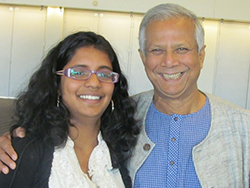 Ananya Cleetus, 17 (Pittsburgh, PA)
Ananya Cleetus, 17 (Pittsburgh, PA)
Seventeen-year-old Ananya Cleetus has worked alongside a charity in New Delhi, India to manufacture and patent a number of her inventions, including "Jaipur Foot" -- an improved prosthetic leg. Her most recent project, a robotic prosthetic hand designed to aid leprosy victims in India, was computer modeled, 3D-printed, wired, sewed, and programmed entirely by Ananya. Her project has earned awards from Yale, Princeton, CMU, Duquesne, and the IEEE -- and Ananya hopes her design will be released to the public soon. Ananya teaches a fully accredited robotics course at a middle school and was named a National Winner for Aspirations in Computing from the National Center for Women and Information Technology. She drums for her local Marching Band Drumline and hopes to one day double major in Electrical Engineering and Computer Science.
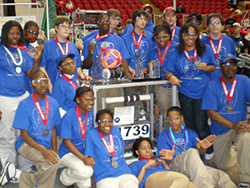 Lydia Wolfe, 16; John Moore, 19 (Chicago, IL)
Lydia Wolfe, 16; John Moore, 19 (Chicago, IL)
Lydia Wolfe, 16, and John Moore, 19, are part of FIRST Robotics Team #1739, “The Chicago Knights” – an ambitious crew of 6th - 12th graders from across Chicago led by a dedicated mentor, Jackie Moore. Together, the team’s mantra is “The game is not the prize, it’s the changes the game brings about in the kids.. What started as a few people working on robots in the basement of the Ford City Mall is now a thriving team working at Level Up – a shared learning space that is open to any students interested in STEM-based after-school programs, summer camps, and “making.” Level Up is, literally, a level up from where this FIRST team started: The team moved upstairs to a bigger, brighter space in the Mall last year.
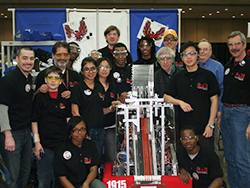 Baldes Foyet-Fokou, 17; J’niya Butler, 15 (Washington, D.C.)
Baldes Foyet-Fokou, 17; J’niya Butler, 15 (Washington, D.C.)
Since 2006, McKinley High Technology School – one of five specialized secondary schools in the District of Columbia -- has proudly hosted the Firebirds FIRST robotics team #1915, a team of students and mentors with a mission to provide kids with exposure to all the possibilities in the STEM fields. The Firebirds, including Baldes Foyet-Fokou, 17, and J’niya Butler, 15, are one of the two oldest FIRST teams in Washington, D.C., and have a strong commitment to the Washington metropolitan robotics community. The team emphasizes that their location in the nation’s capital provides an opportunity to excel in leadership and serve as a role model for a number of local FIRST teams with less experience. The Firebirds do their best to practice "gracious professionalism" with respect to their peer teams – including by conducting open, off-season training workshops for mentors, as well as numerous public events to show their enthusiasm for science and technology.
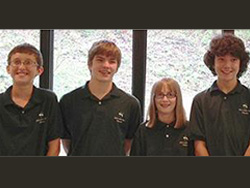 Aaron Knestaut, 13; Eric Long, 14; Max Huhn, 13 (Hockessin, DE)
Aaron Knestaut, 13; Eric Long, 14; Max Huhn, 13 (Hockessin, DE)
Aaron Knestaut, 13, Eric Long, 14, and Max Huhn, 13, are members of the Delaware-based “Zero Waste” team – students focused on helping solve the challenge of Delaware's rapidly filling landfills. The team learned that even with recycling measures in place, the state’s landfills are on track to be filled to capacity by 2030, and set out to solve the problem. Their research revealed that more than half of the waste placed in Delaware’s landfills can actually be composted. By implementing curbside organic composting collection and diverting organic waste away from the landfills, the team expects to extend the life expectancy of the state’s landfills and reduce the negative effects of landfills on the environment. The Zero Waste Team was awarded the $25,000 Columbus Foundation Community Grant for their innovative project.
Related posts:
































